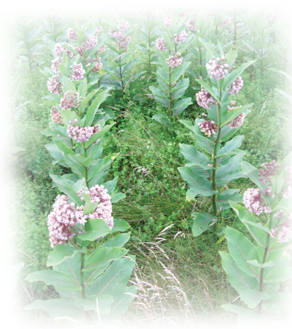Milkweed, silkweed,
petit cochon
|
|
| Asclepias syriaca
Asclepiadaceae
Legend and Lore The genus name asclepias refers to the Greek mythical god of medicine Asclepius, syriaca originally thought from Syria but later rectified and the species name did not change. The confusion stems from another species found in Syria. Milkweed gets its name from the milky sap that seeps out of broken leaves and stems; the medicinal properties of the sap include salves for cuts, burns, infections and irritations. Samuel de Champlain first noticed the plant near Québec City around 1600. The only food for the Monarch caterpillars, milkweed is essential for their annual migration from Mexico. The seed silk was used to stuff pillows, mattresses and woven into cloth fibers. During World War II the seed silk was used to stuff lifejackets. In the Garden Tall perennial up to 2 m in height, leaves are opposite pairs on a single stock measuring 10 to 23cm in length and 5 to 10cm in width on short petioles. Leaves are ovate with a smooth margin, thick but not succulent; pubescent plant with a soft feel, light green with grey down on the underside. The milky sap is latex which flows in copious amounts when bruised. Flowers are pinkish umbels in singles or pairs on the upper third of the plant, with 5 reflexed petals. Pods are elongated, broadest near the base and tapering into a curved point measuring 8 to 14cm. Propagation is by seed or basal cuttings in the spring, or root cutting in the spring or fall. |
|



